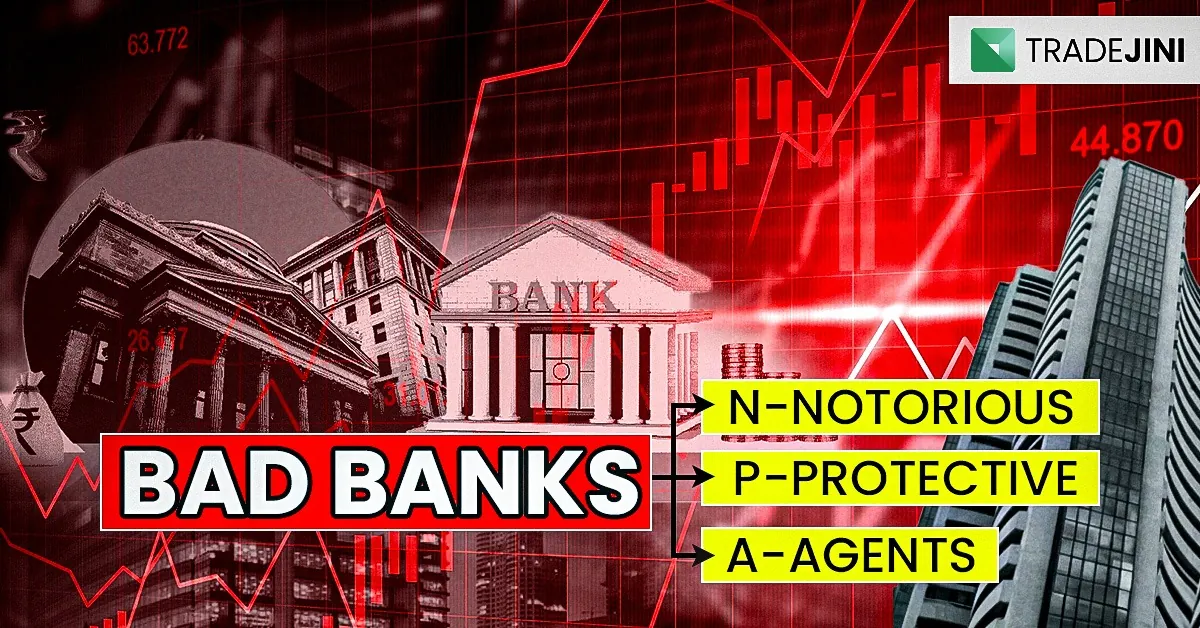In 2021, Finance Minister Nirmala Sitharaman, in her Budget 2021-22 speech, said that the government intended to establish a bad bank to address the issue of bad loans worth approximately Rs 2 lakh crore in the banking system. The aim of this move was to help banks resolve their troubled assets and restore stability in the financial sector.
However, the problem of bad loans has long overwhelmed the Indian banking industry. But before diving into the details, it is essential to understand what bad banks are.
Bad banks
A bad bank is a financial institution that specializes in managing and resolving non-performing assets (NPAs) or bad loans. It is typically set up by a group of banks or financial institutions to help them clean up their balance sheets and get rid of problematic loans that are not being repaid.
These loans that borrowers have defaulted on are unlikely to be paid back. These loans are a significant problem for banks, as they not only reduce their profitability but can also threaten their stability. The accumulation of bad loans can be attributed to various factors, such as the economic slowdown, poor lending practices, and inadequate risk assessment.

History of bad banks
The concept of bad banks has a rich history, with the first instance dating back to 1988, when Mellon Bank in the US established a bad bank to hold its stressed assets. The success of this initiative inspired other countries to adopt the same approach, including the US, Finland, Sweden, Indonesia, and Belgium. The idea of creating a separate entity to manage troubled assets gained popularity during the 1990s, particularly in the wake of the Asian financial crisis. In Europe, the concept of bad banks gained traction during the sovereign debt crisis, with countries like Finland and Sweden setting up their own versions.
How do bad banks work?
A bad bank works by acquiring bad loans from banks at a discounted price, usually below their face value. Then, the bad bank attempts to recover the debt by working with borrowers to restructure their loans, sell off collateral, or take legal action when necessary. The goal is to maximize recoveries and minimize losses for the banks.

National Asset Reconstruction Ltd. (NARC), a state-backed bad bank formed in the year 2021, is an asset reconstruction company. NARC will purchase bad loans from banks, thereby alleviating their non-performing assets (NPA). Subsequently, NARC will strive to sell these stressed loans to distressed debt buyers. Distressed debt buyers focus on acquiring debt securities from entities that encounter financial difficulties, including those on the brink of bankruptcy. The Indian government has already established India Debt Resolution Company Ltd. (IDRCL) to sell these stressed assets in the market. Consequently, IDRCL will make efforts to sell them in the market. After the stressed asset is sold, the respective bank will receive the payment in installments. However, if the bad bank in India is unable to sell the stressed loan at a profit or at all, the government guarantee will come into play.
NARCO-IDRC
Following the guidelines outlined in the "Debt Management Agreement" signed between IDRCL and NARCL, the two corporations will have an exclusive agreement. The resolution will be owned and approved by NARCL as the principal under this arrangement, which will be on a "Principal-Agent" basis. NARCL will initially purchase troubled bank loans. Then, 85% of the agreed-upon amount will be paid in the form of "Security Receipts," with 15% of that total paid in cash.
Objectives of NARCL-IDRCL
National Asset Reconstruction Company Limited (NARCL): NARCL's primary objective is to dispose of commercial banks' stressed assets.
India Debt Resolution Company Ltd. (IDRCL): IDRCL's main goal is to sell off the bank's stressed assets in the market.
There are four main categories of bad bank structures. The objectives of a bad bank vary, but the primary goal is to help banks restore confidence in the financial system and focus on their core business of taking deposits and lending money.
Bad Bank Spinoff
A bad bank spinoff is a separate legal entity that acquires all of the bank's troubled assets. This structure is the most common type of bad bank and allows banks to clean up their balance sheets and remove problematic assets. The bad bank then manages and resolves the acquired assets, maximizing recoveries and minimizing losses for the bank.
Balance Sheet Guarantee
A balance sheet guarantee is an arrangement where the government supports a portion of the bank's portfolio losses. This provides assurance to the bank that the government will back them up in case of losses, allowing them to take risks and lend more confidently.
Internal Restructuring
Internal restructuring involves creating a distinct internal division within the bank to house troubled assets. This structure is common when the number of problematic assets in the bank's balance exceeds 20%. The internal restructuring team manages and resolves the assets, aiming to maximize recoveries and minimize losses.
Special purpose entity
A special purpose entity is a separate legal entity that acquires and manages troubled assets from the bank. The government typically supports this type of bad bank, providing assurance to the bank that the government will back them up in case of losses. The special purpose entity manages and resolves the acquired assets, maximizing recoveries and minimizing losses for the bank.

Does bad banking help?
The establishment of a bad bank can be beneficial for several reasons. Firstly, it helps banks clean up their balance sheets and get rid of toxic assets that can hamper their ability to lend and invest. Secondly, it helps to restore confidence in the financial system by addressing the issue of NPAs, which can undermine the stability of banks and the economy as a whole. Finally, a bad bank can help to recover funds for banks, which can then be used to support new lending and investment activities.
While bad banks can provide relief to banks by acquiring their troubled assets, the lack of effective recovery tools and investor confidence in debt resolution circles raises doubts about their efficacy.
It's worth noting that the concept of a bad bank is not unique to India. Many countries have set up similar institutions to address the problem of NPAs in their financial systems. For example, the United States had a similar institution called the Resolution Trust Corporation (RTC) during the savings and loan crisis in the 1980s.
‘A bad bank is not a time bomb, nor is it a quick fix. It's an initiative that lies in the execution, not the concept.’



